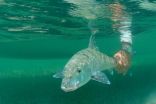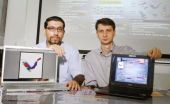Medical imaging breakthrough uses light and sound to see microscopic details inside our bodies
New research in the FASEB Journal shows how combining photoacoustic tomography with gold nanobeacons allows researchers to see blood vessel formation in detail without a microscope
2010-11-23
(Press-News.org) See it for yourself: a new breakthrough in imaging technology using a combination of light and sound will allow health care providers to see microscopic details inside the body. Access to this level of detail potentially eliminates the need for some invasive biopsies, but it also has the potential to help health care providers make diagnoses earlier than ever before—even before symptoms arise. Details describing this advance are published online in the FASEB Journal (http://www.fasebj.org/content/early/2010/11/19/fj.10-171728.abstract).
In the online research report, researchers from St. Louis describe how they combined photoacoustic tomography (PAT) with gold nanobeacons (GNB) to achieve an unprecedented level of imaging detail. Specifically, the researchers were able to identify the first signs of new blood vessel growth, which is necessary for new tumors to form. Specifically, not only were the newest blood vessels with initial blood flow imaged, but pre-vessel formation of inter-vessel bridges and vessel off-shoot sprouts in which blood flow had yet to begin also were captured. This is the first time that the angiogenic process was imaged in such clear detail without a microscope. The scientists anticipate that the combined use of PAT and GNB will be able to further pinpoint precise molecular disease markers.
According to one of the researchers involved in the work, Dipanjan Pan, Ph.D. from the Consortium for Translational Research in Advanced Imaging and Nanomedicine at the Washington University School of Medicine, "This study further establishes the opportunity provided by molecular imaging and photoacoustic tomography to identify, characterize, and guide the rational management of high-risk patients with life-threatening disease earlier when treatment is the most likely to help and quality of life is best preserved."
To make this advance, the researchers implanted mice with a gel (Matrigel™) that stimulates natural capillary formation, mimicking the same process occurring in an aggressive cancer or unstable atherosclerotic plaque. Then they used GNB to target a prominent molecular indicator of proliferating new vessels. Unlike common ultrasound techniques that send in a sound wave and "listen" for the echo, PAT sends in a light beam that excites and warms certain proteins, such as the hemoglobin in red blood cells. The minutely heated proteins emit a sound wave that is then detected by the ultrasound transducer.
"This type of imaging verges on Star Trek territory," said Gerald Weissmann, M.D., Editor-in-Chief of the FASEB Journal. "We're now exploring inner space with tools developed for outer space.
Early tumors and latent infections give rise to microscopic changes in blood vessels that no one could pick up until this technique came along. It's the new age of nanomedicine."
###
Receive monthly highlights from the FASEB Journal by e-mail. Sign up at http://www.faseb.org/fjupdate.aspx. The FASEB Journal (http://www.fasebj.org) is published by the Federation of the American Societies for Experimental Biology (FASEB). The journal has been recognized by the Special Libraries Association as one of the top 100 most influential biomedical journals of the past century and is the most cited biology journal worldwide according to the Institute for Scientific Information.
FASEB comprises 23 societies with more than 100,000 members, making it the largest coalition of biomedical research associations in the United States. FASEB enhances the ability of scientists and engineers to improve—through their research—the health, well-being and productivity of all people. FASEB's mission is to advance health and welfare by promoting progress and education in biological and biomedical sciences through service to our member societies and collaborative advocacy.
Details: Dipanjan Pan, Manojit Pramanik, Angana Senpan, John S. Allen, Huiying Zhang, Samuel A. Wickline, Lihong V. Wang, and Gregory M. Lanza
Molecular photoacoustic imaging of angiogenesis with integrin-targeted gold nanobeacons
FASEB J. doi:10.1096/fj.10-171728 ; http://www.fasebj.org/content/early/2010/11/19/fj.10-171728.abstract
END
ELSE PRESS RELEASES FROM THIS DATE:
2010-11-23
The link between sleeping and obesity is drawn tighter as a new research published online in the FASEB Journal (http://www.fasebj.org/content/early/2010/11/19/fj.10-172080.abstract) study shows that what your mother ate when she was pregnant may make you obese or overweight by altering the function of genes (epigenetic changes) that regulate circadian rhythm. In the report, pregnant primate females consuming a high-fat diet altered the function of fetal genes that regulate circadian rhythm (including appetite and food intake) during development. The offspring also had non-alcoholic ...
2010-11-23
EAST LANSING, Mich. — Late-preterm babies – those born between 34 and 36 weeks – are at an increased risk for cognitive and emotional problems, regardless of maternal IQ or demographics, according to new research published by Michigan State University researchers in the current edition of the journal Pediatrics.
While late-preterm births (full-term pregnancies last at least 37 weeks) have been associated with such problems before, the study represents one of the most rigorous looks at the issue by accounting for other potential causes, said the study's lead author, Nicole ...
2010-11-23
Most patients who take anti-depressants give up their treatment in less than six months, the minimum period recommended for treating severe depression and other derived pathologies. This is the conclusion of a new study carried out by Catalan researchers, which reveals that only 25% continue their treatment for more than 11 months.
"Only one in every five patients properly completes their treatment", Catalina Serna, co-author of the study, and an expert at the Jordi Gol Primary Care Research Institute (IDIAP) in Lleida, tells SINC.
From 2003 to 2007, researchers from ...
2010-11-23
Amyotrophic lateral sclerosis (ALS) is a fatal neurodegenerative disease that eventually destroys most motor neurons, causing muscle weakness and atrophy throughout the body. There is no cure and the current treatment has only a moderate effect on the march of the disease, which typically kills within three to five years. This week in PNAS, a team of Brandeis scientists reports an innovative approach to treating the most common form of familial ALS, commonly known as Lou Gehrig's disease.
In the study, researchers studied mutations in the gene that makes a particular ...
2010-11-23
Nov. 22, 2010 -- More than 170 participants gathered this week for the eighth annual National Academies Keck Futures Initiative (NAKFI) conference in Irvine, Calif. This year's topic, imaging science, a field of study that uses physics, chemistry, mathematics, computer science, and cognitive sciences to understand the many factors that influence and enable image capture and analysis. At the conference, top researchers from different fields discussed imaging science and its far-reaching applications -- such as astronomy, environmental monitoring, education, and health ...
2010-11-23
Johns Hopkins Children's Center scientists have discovered that high blood levels of a protein commonly found in the central nervous system can predict brain injury and death in critically ill children on a form of life support called extra-corporeal membrane oxygenation or ECMO.
ECMO, used to temporarily oxygenate the blood of patients whose heart and lungs are too weak or damaged to do so on their own, is most often used as a last resort because it can increase the risk for brain bleeding, brain swelling, stroke and death in some patients.
A detailed report of the ...
2010-11-23
HIV infected patients whose treatment is delayed not only become sicker than those treated earlier, but also require tens of thousands of dollars more in care over the first several years of their treatment.
"We know that it's important clinically to get people into care early because they will stay healthier and do better over the long run," says Kelly Gebo, M.D., M.P.H., an associate professor of medicine in the Division of Infectious Diseases at the Johns Hopkins University School of Medicine and the study's senior author. "But now we know it's also more costly to ...
2010-11-23
You detect an object flying at your head. What do you do? You probably first move out of the way -- and then you try to determine what the object is. Your brain is able to quickly switch from detecting an object moving in your direction to determining what the object is through a phenomenon called adaptation.
A new study in the Nov. 21 advance online edition of the journal Nature Neuroscience details the biological basis of this ability for rapid adaptation: neurons located at the beginning of the brain's sensory information pathway that change their level of simultaneous ...
2010-11-23
MIAMI – November 22, 2010 – This October more than 60 guides and anglers in the Florida Keys poled across the flats from Biscayne Bay to the Marquesas, assisting in the annual bonefish census. This year's count, held in extremely difficult weather with lowered visibility, was down by 25-percent from an 8-year mean estimate of 316,805 bonefish to a new low of about 240,000 bonefish, according to Professor Jerry Ault, a fisheries scientist with the University of Miami's Rosenstiel School of Marine & Atmospheric Science.
"Since 2003 we have conducted an annual bonefish ...
2010-11-23
In the future, tiny air vehicles may be able to fly through cracks in concrete to search for earthquake victims, explore a contaminated building or conduct surveillance missions for the military. But today, designing the best flying mechanism for these miniature aerial machines is still a challenging task.
Creating micro-scale air vehicles that mimic the flapping of winged insects or birds has become popular, but they typically require a complex combination of pitching and plunging motions to oscillate the flapping wings. To avoid some of the design challenges involved ...
LAST 30 PRESS RELEASES:
[Press-News.org] Medical imaging breakthrough uses light and sound to see microscopic details inside our bodies
New research in the FASEB Journal shows how combining photoacoustic tomography with gold nanobeacons allows researchers to see blood vessel formation in detail without a microscope




